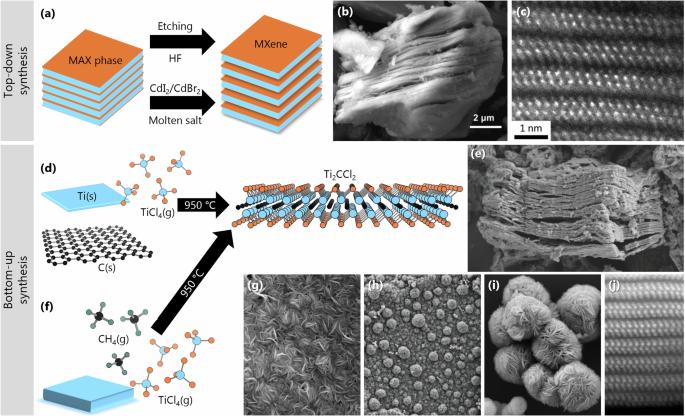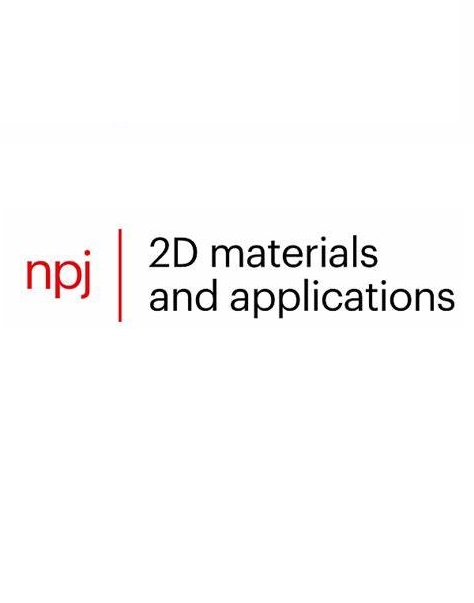二甲苯中的查耳根和卤素表面终止覆盖层--结构、稳定性和特性
IF 8.8
2区 材料科学
Q1 MATERIALS SCIENCE, MULTIDISCIPLINARY
引用次数: 0
摘要
MXenes 是二维(2D)过渡金属碳化物、氮化物和碳氮化物的一个多样化家族。它们既可以通过自上而下的方法合成,如使用酸或熔盐从 MAX 相中选择性蚀刻 A 层,也可以通过自下而上的方法合成,如使用化学气相沉积直接合成。然而,表面终止覆盖的程度取决于合成途径,也是控制其特性的一个关键参数。本研究的重点是卤素和缩醛基封端 MXenes,特别是 M2CTx,其中 M = Ti、Zr、V、Nb、Ta,T = S、Se、Te、Cl、Br、I,表面封端覆盖率从 100% (理想 x = 2)到 50% (x = 1)不等。此外,还评估了氧在空置终止位点上的结合情况。利用密度泛函理论(DFT)计算,我们研究了这些 MXenes 的结构、电子和机械特性。我们的研究结果表明,非理想终止覆盖(x <2)更有利于以较大尺寸的 T(如 Ti2CBrx、Nb2CClx 和 Ta2CClx)终止的 MXenes,并导致混合终止位点和较低的结合能。结合能的降低可能会促进单片的分层,但过低的终止覆盖率也可能导致结构崩溃。电子特性显示,在非理想覆盖率下,费米级上的状态数量增加,从而有可能提高导电性。在力学方面,我们发现 MXenes 的模量与其他二维材料(如过渡金属瑀和六方氮化硼)相当,这表明它们适用于需要灵活性和耐久性的应用。这项研究强调了通过精确控制终止覆盖和组成来定制 MXene 特性的潜力,为提高特定应用性能铺平了道路。本文章由计算机程序翻译,如有差异,请以英文原文为准。

Chalcogen and halogen surface termination coverage in MXenes—structure, stability, and properties
MXenes are a diverse family of two-dimensional (2D) transition metal carbides, nitrides, and carbonitrides. They can be synthesized through both top-down approaches, such as selective etching of A-layers from MAX phases using acids or molten salts, and bottom-up approaches, such as direct synthesis using chemical vapor deposition. However, the degree of the surface termination coverage depends on the synthesis route and is one key parameter for controlling its properties. This study focuses on halogen- and chalcogen-terminated MXenes, particularly M2CTx where M = Ti, Zr, V, Nb, Ta, and T = S, Se, Te, Cl, Br, I, and with surface termination coverage ranging from 100% (ideal, x = 2) to 50% (x = 1). The incorporation of oxygen on vacant termination sites was also evaluated. Using density functional theory (DFT) calculations, we investigated the structural, electronic, and mechanical properties of these MXenes. Our findings reveal that non-ideal termination coverage (x < 2) is more favorable for MXenes terminated with a larger size of T, such as Ti2CBrx, Nb2CClx, and Ta2CClx, and leads to mixed termination sites and lower binding energies. A reduced binding energy may facilitate delamination into single sheets, however, too low termination coverage may also cause structural collapse. Electronic properties showed an increased number of states at the Fermi level under non-ideal coverage, potentially enhancing the conductivity. Mechanically, we find the moduli of MXenes to be comparable to other 2D materials, such as transition metal chalcogenides and hexagonal boron nitride, indicating their suitability for applications requiring flexibility and durability. This study underscores the potential of tailoring MXene properties through precise control of termination coverage and composition, paving the way for enhanced application-specific performance.
求助全文
通过发布文献求助,成功后即可免费获取论文全文。
去求助
来源期刊

npj 2D Materials and Applications
Engineering-Mechanics of Materials
CiteScore
14.50
自引率
2.10%
发文量
80
审稿时长
15 weeks
期刊介绍:
npj 2D Materials and Applications publishes papers on the fundamental behavior, synthesis, properties and applications of existing and emerging 2D materials. By selecting papers with the potential for impact, the journal aims to facilitate the transfer of the research of 2D materials into wide-ranging applications.
 求助内容:
求助内容: 应助结果提醒方式:
应助结果提醒方式:


